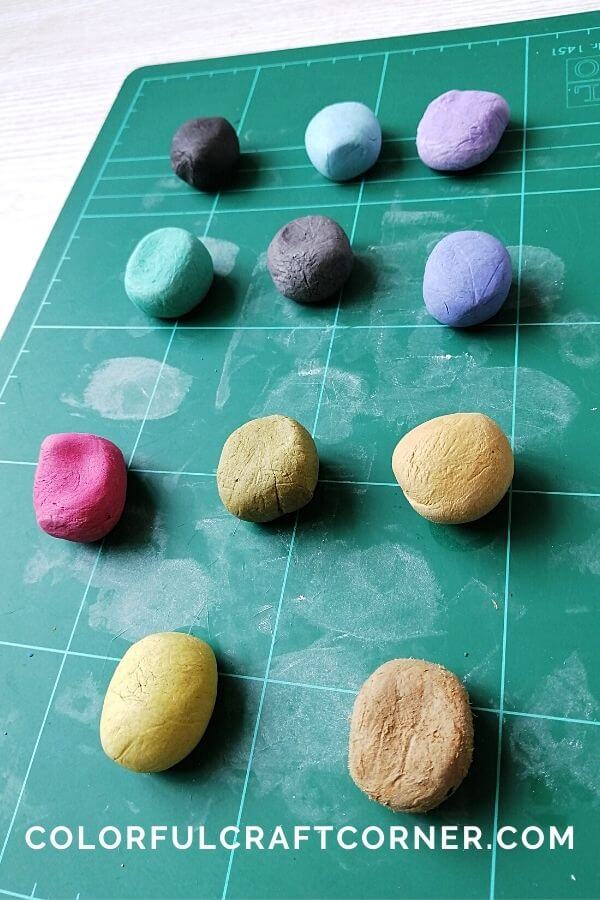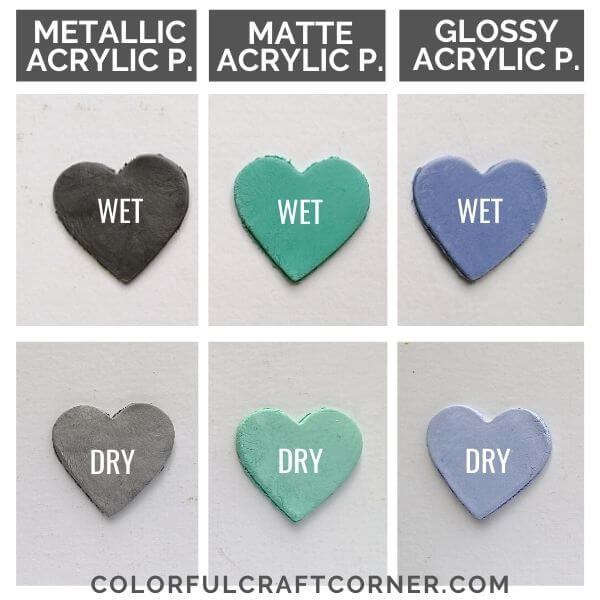10 Everyday Paints to Color Air Dry Clay
Did you know that you can make colored air dry clay? I’ve kept seeing other crafters mention in their articles and tutorials, that you can color air-dry clay with soft pastels or acrylic paint. Usually, they didn’t show or do it, just casually mentioned it.
It bugged me for weeks! How to color air dry clay? What can you use to make colored clay? So, I decided to run an experiment. I used white DAS air hardening clay and 10 (actually 12) paints and colors to make colored clay. Is DAS air hardening clay good? Read my experience with the clay.
You can buy air drying clay in limited colors: white, terracotta, and grey colors. On the contrary, polymer clay comes in lots of shades, effects, and textures. If I want to be exact, colored air modeling clay is available for children (for example, this kit), but it has a different, fluffier consistency compared to the ‘regular’ clay.
But now, let’s get to the fun part and the results!
DISCLOSURE: THIS POST MAY CONTAIN AFFILIATE LINKS, MEANING I GET A COMMISSION IF YOU DECIDE TO MAKE A PURCHASE THROUGH MY LINKS, AT NO COST TO YOU. PLEASE READ MY DISCLOSURE FOR MORE INFO.
Table of Contents:
- What I used to color air dry clay
- How to color air dry clay
- How to achieve the same color shades
- General findings of coloring clay at home
- Colored clay results
- Conclusion

What I used to color air dry clay:
- acrylic paint (glossy, matte, and metallic),
- tempera,
- fabric dye,
- fabric paint,
- watercolors,
- soft pastels,
- black Chinese ink,
- instant coffee,
- turmeric,
- food coloring.
Every paint or color type mentioned above is suitable for coloring air dry clay. Some are easier to work with, some have downsides, but you can color small pieces of clay with them.
The best paint to color air dry clay is tempera. It’s easy to incorporate into the clay and gives rich color. The only reason I picked tempera and not acrylic paint is being washable. Acrylic paints are as good as tempera, but make sure you protect your clothes, table, and hands.
Let’s start with the process of coloring clay, then I’ll share some general findings, and I’ll summarize them in a table with suggestions.
How to color air dry clay
First, you have to know that it’s MESSY!
Protect your worktable, clothes, and hands.
I covered my table with a piece of plastic wrap, and I used thin rubber gloves. I haven’t covered my clothes, but you have to know that, acrylic paint once it’s dry won’t come off. So, choose your ‘crafting clothes’ wisely.
Soften the clay a little bit by molding it with your hands. Flatten it a little bit and poke one or more holes (based on the size of your clay) and fill them with the paint of your choice.
You may need to add a few drops of water when mixing powdered pigments. It will help to mix evenly and so the clay won’t dry out.
Stretch it, mold it, fold it until the pigments distribute evenly. It will take a couple of minutes (the bigger the clay, the longer it will take).

How to achieve the same color shades?
Did you manage to make an awesome and unique colored clay? And now you wonder how to replicate it either for personal use or if you sell handmade goodies.
There is a ‘magic tool’! -the clay mixing ruler.
It’s perfect to duplicate colors. Put the ruler on the clay and put the paint in one of the holes for measuring. But don’t forget to write it down so you can achieve the hues over and over again!
For example, 10g clay + one A blue + two A green (‘A’ stands for the hole size on the ruler) for a nice turquoise color.
You should also write down:
- the paint type (e.g. acrylic, tempera, also the name of the brand),
- the exact color names (e.g. primary blue, cobalt blue, sky blue, phthalo blue, etc.)
For liquid paint use a pipette. These plastic disposable pipette droppers are perfect for measuring and adding ink, liquid watercolors, or liquid food coloring to clay.
General findings of coloring clay at home
1. Mixing
Paste-like colors were the easiest to blend in the clay. With the liquid paint, I had to be careful, because it was runny. Powdered pigments weren’t actually hard to incorporate but took me longer. Mixing a bigger chunk of air dry clay with powder would take significantly longer and more difficult to incorporate than using a paste or liquid.
So, for coloring small pieces of clay, every type of paint is perfect. For a larger project, I suggest using wet colors.
2. Color saturation
First of all, you won’t be able to make those vivid and strong colors that come packed in children’s clay or polymer clay. Unless you make homemade air dry clay. It’s super easy to mix pigments into the clay before it’s cooked, and you can make the colors a lot richer. Check out this tutorial for 3 homemade air hardening clay recipes.
The end colors are pastels, more vivid while still wet, and lighter after drying. You can control the color saturation to a certain degree by adding ore pigments. But since you are using a white medium you won’t be able to make really strong colors.
The color of the clay
Also, using certain brands of air hardening clay will determine your end colors. For example, I used DAS air dry clay, which is more of a light grey clay that mutes the colors. Choosing bright white clay would make the colors more radiant.
Applying a varnish
Usually applying some sort of sealant, varnish or lacquer enlivens painted objects. So, I did a small test within the experiment (Craft Inception! lol). I used a water-based, matte varnish on half of the hearts to see if it would make a difference.
As you can see in the photo, the varnish helped a bit. The clay hearts regained their color a bit.
However, some of them changed colors: the powder dyed and the watercolor painted clay (more about this later). I think it was a reaction between the ingredients. It’s something you should consider and test when you make your own projects if you don’t want unwanted surprises. See the result in the photo below.

Colored clay results
1. Acrylic Paint
I tried three types of acrylics with a different finish: glossy, matte, and metallic, to see if it would make a difference. The shiny and matte acrylics worked and looked the same after incorporating them into the clay. The metallic acrylic paint had a subtle shimmery effect.

2. Tempera
The creamy texture blends nicely with the air dry clay. The pigments are rich enough to give a nice, strong color just like the acrylic paints. The advantage compared to acrylic paint is that tempera is washable and non-toxic. It cleans easily from the table, clothes, and hands (harder to get it off from around the nails).
3. Fabric Dye
I wasn’t satisfied with this type of pigment because the package said ‘Banana Green’. The dye colored the clay to a light yellow and became bumpy after drying. The green color I was expecting appeared after applying the varnish. Maybe I should have diluted the dye with a few drops of water, or used liquid fabric dye instead.
4. Fabric Paint
Just like the acrylics and the tempera, fabric paint colored the clay nicely. It was easy to incorporate into the clay. I would recommend using it for this purpose if you don’t have any other type of paint for coloring.

5. Watercolors
To color the clay with watercolors, I wet my brush and tried to dilute as much pigment as I could, before mixing in. I liked the nice purple shade, which turned into a light pink after applying the varnish. I would substitute regular watercolors with liquid watercolors because they have rich pigments and beautiful vivid colors.
6. Soft Pastels
I used a craft knife to turn a small piece of pastels into a powder. The pigments are not as strong as the others mentioned in the article. It was a bit challenging to blend in because bigger particles came to the surface all the time. They left color paths as I molded the clay. After drying the color became pretty subtle. The varnish didn’t really enhance the hue.
7. Black Chinese Ink
In the beginning, blend the ink carefully and slowly into the clay. If you hurry (like I did) it will squirt small black drops all over the place, almost unnoticeably. Ink has high-pigment density, so they result in stronger colors. They are perfect for coloring air hardening clay. For other colors, try alcohol inks.

8. Instant Coffee
The brown end color, after mixing the clay with instant coffee, is nice. However, there are two aspects I don’t like. While mixing the clay it became flaky. Although, I didn’t have any problem rolling it out between two sheets of plastic wrap. It also looks good after drying, but it has a light odd odor (not a pleasant coffee smell).
9. Turmeric
Turmeric had a light coloring effect on the clay in the first place, but after a few days, the upper part became even lighter. It has a light turmeric scent. The varnish didn’t enhance the color in this case.
10. Food Coloring
Since it’s a liquid it was fairly easy to incorporate it into the clay. However, it seemed that the pigments weren’t as good. Maybe because of the brand, or in general, food coloring doesn’t have as rich pigments as watercolors, ink, or other paints. I would also give a try to gel food coloring.

INTERPRETATION: Moderate 1 – Liquid colors – challenging to keep on the clay at the beginning. Moderate 2 – powder pigments – challenging to incorporate into the clay.
Here is a table that summarizes my results for transparency and a few suggestions.
| PAINT/COLOR TYPE | MIXING | COLOR SATURATION | NOTES & SUGGESTIONS |
| 1.1. Glossy Acrylic Paint | Easy | Good | Use professional acrylic paint, because they have rich, non-fading pigments. |
| 1.2. Matte Acrylic Paint | Easy | Good | Test other acrylic paints with different effects like neon, glow in the dark, pearl, or iridescent to find new results. |
| 1.3. Metallic Acrylic Paint | Easy | Subtle shimmery effect | If you’re looking for a more glimmery effect try metallic pigment powders. |
| 2. Tempera | Easy | Good | Experiment with glow-in-the-dark, glittery, and neon colors. This set is perfect for that. |
| 3. Fabric Dye | Moderate 2 | Different from what I’ve expected. | Varnish may change the color. Use liquid fabric dye instead. |
| 4. Fabric Paint | Easy | Good | Just like with tempera or acrylic paint, experiment with colors and effects. |
| 5. Watercolors | Moderate 1 | Good, nice hue | Varnish may change the color. Use liquid watercolors for more vivid colors. |
| 6. Soft Pastel | Moderate 2 | Subtle | Use a rasp or a mortar and pestle to turn pastels into a fine powder for coloring. |
| 7. Black Chinese Ink | Moderate 1 | The richest | For other colors, test alcohol inks. |
| 8. Instant Coffee | Moderate 1 | Light brown | Has a ‘weirdish’ smell. Mix the clay with ground coffee instead for a cool speckled effect. |
| 9. Turmeric | Moderate 2 | Very subtle coloring | Try other spices and natural powders for coloring: red beet, hibiscus, carrot, spirulina powder, etc. |
| 10. Food Coloring | Moderate 1 | Good | Try gel food coloring or make your own unique homemade food coloring. |
Conclusion
As you can see it’s fairly easy to create colored clay from store-bought air dry clay. If you are a regular crafter, I’m sure you have several of the paints I used for this experiment at home right now. I encourage you to try and make colored clay! Ask your spouse to join you, or involve your kids to make fun colored clay crafts together!
In my opinion, the best paint for coloring clay is acrylic paints or tempera. They colored the clay nicely and were easy to work with. If I had to pick one, I would choose tempera. The only reason is that it’s washable.
It was so much fun to make this test. I was so curious how it would turn out. I’m sure I’ll make other ‘tests’ like this in the future (Soon). The next one will cover how to add texture and all sorts of fun effects to the clay.
So, stay tuned! Sign-up for my newsletter so you won’t miss other fun experiments and crafts!
Related Air Dry Clay Articles:
- Cute Things to Make Out of Air Hardening Clay
- What to Make Out of Air Modeling Clay
- Easy Air Dry Clay Bird Sculpture
- Air Dry Clay Bunny Tutorial
- Fun Air Drying Clay Kits for Adults
- Is Air Dry Clay Food-Proof?



Super helpful and cool post! Thank you 🙂
Thank you, Joyce! 🙂 I’m happy you liked it.
So useful thank you for making a mess for the good of the crafting! lol
You’re welcome! I love to make a mess (lol). I’m happy you liked it and found it useful. 🙂
Awesome information. I have just started to ‘play’ with clay and had a lot of questions, and you have taken care of most of them. Thank you for sharing your knowledge. Oh what fun this will be.
Thank you, Dawna! I love to read comments like yours! I’m so happy when I can help and/or inspire others 🙂
Hi there. Can’t wait to try all of these methods :).
Quick question: do you know an air drying clay that dries up white (or much whiter than Das)?
Thanks in advance,
C
Hi Christina 🙂 Jovi air dry clay is whiter and the consistency is a lot creamier than DAS. However, it won’t dry to a super-sparkly white (if you’re looking for that). The whitest clay I’ve worked with was the homemade cornstarch and baking soda clay.
Thanks. Taken a lot of effort! Can you also show the effect on colour after a period of time with varnish/coating and without. does it fade away?
I’ve made this experiment approx. 10 months ago. The colors haven’t changed. I’m not sure how they will change in the long run. It’s always best to keep away from direct sunlight because it will make them fade.
This was really helpful, I have tried food colors, watercolors and soft pastel, but colors faded in my case, I will try with acrylics! thank you. Happy 2023
You’re welcome. Happy 2023 to you too!